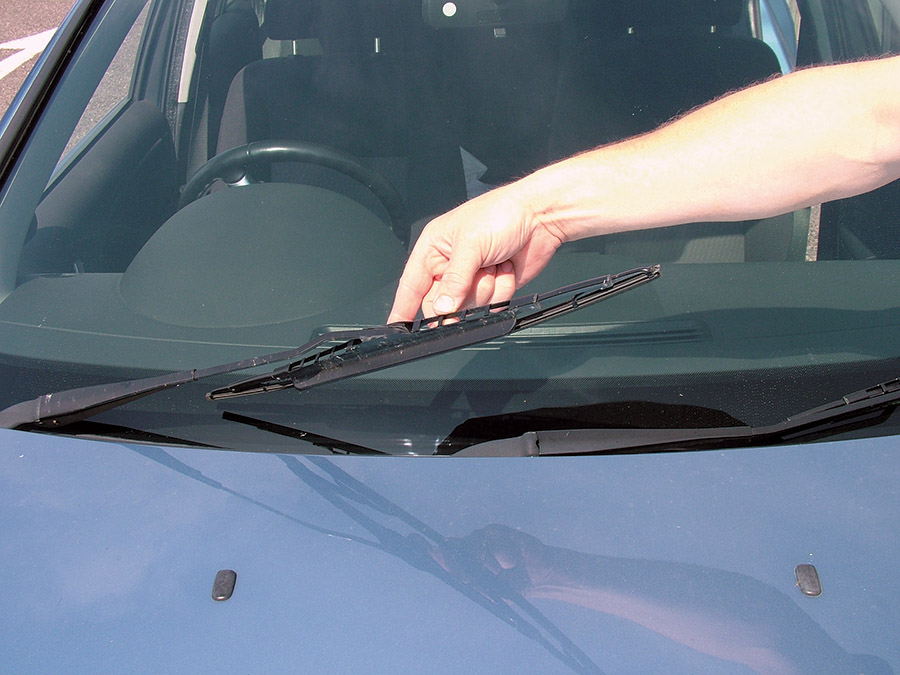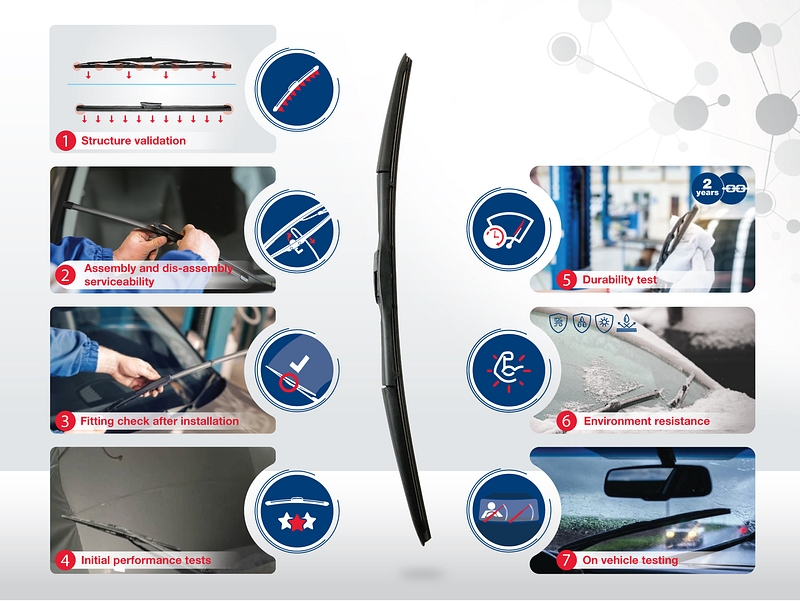How to Check Wiper Blades
To check wiper blades, inspect for any visible wear or damage on the rubber blade. Checking wiper blades regularly ensures optimal performance and visibility during rainy or snowy conditions.
Worn-out or damaged wiper blades can leave streaks on the windshield, reducing visibility and posing a safety hazard. By performing a quick visual inspection and running the wipers to test their functionality, you can assess if it’s time to replace them.
Timely replacement of wiper blades can help maintain clear visibility and ensure safe driving in adverse weather conditions. Follow these simple steps to keep your wiper blades in top condition and ensure clear visibility on the road.

Credit: stxrentalcar.com
Importance Of Checking Wiper Blades
Wiper blades are crucial for maintaining visibility during inclement weather, so it’s important to regularly inspect them for wear and tear. Checking for cracks, streaks, and proper alignment can help ensure they function effectively, enhancing safety on the road. Regular maintenance can extend the lifespan of wiper blades and improve overall driving visibility.
Your wiper blades play a crucial role in ensuring clear visibility and safety while driving in all conditions. Neglecting to check and maintain your wiper blades can compromise your ability to see the road clearly, increasing the risk of accidents. It is important to regularly inspect and replace worn-out wiper blades to ensure optimal performance when you need them the most.
Clear Visibility In All Conditions
When it comes to driving, clear visibility is paramount. Your wiper blades are the first line of defense against rain, snow, and other elements that can obstruct your view. Over time, however, wiper blades become worn and less effective, resulting in streaks, smears, and reduced visibility. By checking and maintaining your wiper blades, you can ensure that they are in good condition to provide maximum clarity, allowing you to navigate safely on the road.
Safety While Driving
In addition to clear visibility, properly functioning wiper blades contribute to safe driving. When rain or snow starts to fall, it is critical to have wiper blades that can swiftly clear the windshield, giving you a clear line of sight. Without efficient wiper blades, driving in adverse weather conditions becomes significantly more hazardous as your ability to spot potential obstacles and react quickly becomes compromised. By keeping your wiper blades in top-notch condition, you can drive with confidence and prioritize the safety of yourself and others on the road.

Credit: haynes.com
When To Check Wiper Blades
Visible Wear And Tear
Inspect wiper blades for any visible signs of damage or wear regularly.
If you notice any cracks, tears, or detachment, it’s time to replace them.
Streaking On Windshield
- Look for streaks or smudges left on the windshield after using the wipers.
- This indicates worn blades that are not effectively clearing the windshield.
- Replace the blades to ensure clear visibility during rainy conditions.
How To Check Wiper Blades
To ensure optimal performance and safety while driving, checking your wiper blades regularly is essential. Proper maintenance of your wiper blades can help improve visibility during adverse weather conditions. Here’s a guide on how to check your wiper blades effectively.
Inspecting The Rubber
Begin by examining the rubber part of the wiper blade for any signs of cracking or splitting. If you notice any visible damage, it’s time to replace the wiper blades.
Examining The Frame
Next, carefully inspect the frame of the wiper blade for corrosion or rust. Ensure the frame is securely in place and there are no loose components that could affect the performance of the wiper blades.
Common Wiper Blade Issues
When it comes to ensuring clear visibility on the road, having well-functioning wiper blades is essential. However, wiper blades, like any other vehicle component, can experience issues over time. In this section, we will discuss two common wiper blade issues that you should be aware of: cracks and splits and loose or bent wiper arms.
Cracks And Splits
One common issue that can occur with wiper blades is the development of cracks and splits. These can be caused by exposure to harsh weather conditions, such as extreme heat or cold, as well as prolonged sun exposure. When cracks and splits occur, it can significantly impact the performance of your wiper blades, leading to streaks, smears, and reduced visibility during rain or snow.
If you notice cracks or splits on your wiper blades, it’s important to replace them as soon as possible. Continuing to use damaged blades can further compromise their effectiveness and potentially damage your windshield. Regularly checking the condition of your wiper blades and replacing them when needed will help ensure optimal visibility on the road.
Loose Or Bent Wiper Arms
Another issue that can arise with wiper blades is loose or bent wiper arms. Over time, the mechanical components of the wiper arms can become loose or suffer from wear and tear. This can result in the wiper blades not making proper contact with the windshield, leading to inefficient wiping and decreased visibility.
To check for loose or bent wiper arms, gently lift the wiper arm away from the windshield and observe its movement. If the arm feels loose or appears to be bent, it may be time to replace it. Additionally, if you notice that the wiper blades are not in the correct resting position when not in use, it may indicate an issue with the wiper arm.
Regular inspection and maintenance of your wiper blades can help prevent these common issues. By addressing any problems promptly, you can ensure that your wiper blades continue to provide the clear visibility you need, no matter the weather conditions.
Replacing Wiper Blades
Ensuring that your wiper blades are in top condition is essential for maintaining visibility while driving in adverse weather conditions. If your wiper blades are leaving streaks, squeaking, or not effectively clearing your windshield, it’s time to replace them. With the right replacement and a step-by-step process, you can ensure your wiper blades are performing at their best.
Choosing The Right Replacement
When choosing replacement wiper blades, it’s crucial to select the correct size and type for your vehicle. Consult your owner’s manual or use a wiper blade size guide to determine the right fit. Additionally, consider the material of the wiper blade, such as rubber or silicone, to ensure longevity and effectiveness in clearing your windshield.
Step-by-step Replacement Process
- Start by lifting the wiper arm away from the windshield and locate the release mechanism.
- Press the release tab and carefully slide the old wiper blade down and off the arm.
- Align the new wiper blade with the arm, making sure it securely clicks into place.
- Gently lower the wiper arm back to the windshield.
- Test the new wiper blades to ensure they are properly installed and functioning effectively.

Credit: www.denso-am.eu
Frequently Asked Questions On How To Check Wiper Blades
How Do I Know If My Wiper Blades Need Replacing?
Check for these signs: streaking, skipping, squeaking, smearing or poor cleaning. Replace wiper blades if damaged or worn. Inspect rubber for cracks or splits, and ensure they make secure, even contact with the windshield. Proper visibility is crucial for safe driving in all weather conditions.
How Do I Know If Windshield Wipers Are Bad?
Check for streaks, skips, or squeaking when windshield wipers are in use – these indicate they need replacement.
How Often Should You Change Wiper Blades?
You should change wiper blades every 6-12 months or when streaking, chattering, or smearing occurs during use.
How Do You Diagnose A Bad Wiper Arm?
To diagnose a bad wiper arm, check for signs of malfunction like streaking or skipping on the windshield. Inspect for loose or bent arms, worn out or cracked rubber blades, and unusual noises during operation. Replace the faulty wiper arm if necessary for optimum windshield cleaning performance.
Why Are Wiper Blades Important For Your Car?
Wiper blades are crucial for visibility in wet conditions, ensuring safe driving.
How Often Should I Check My Wiper Blades?
Regularly inspect wiper blades, ideally every six months, for wear and tear.
What Are The Signs Of Worn Wiper Blades?
Streaking, smearing, skipping, or squeaking indicate worn wiper blade issues.
Conclusion
Regularly checking your wiper blades is essential for maintaining visibility on the road. By following a few simple steps, you can ensure that your wiper blades are in good condition and ready to tackle any weather condition. Remember to inspect the blades for any signs of wear or damage, such as cracks or tears.
Replace them if necessary to prevent streaking or smearing. Don’t overlook this crucial maintenance task and stay safe behind the wheel.


